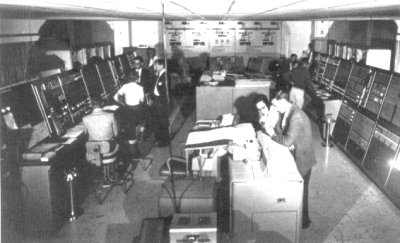AN/FSQ-7 "Whirlwind II" & AN/FSP-8 Intercept Computer
 The Maintenance Control Console of the AN/FSQ-7 Computer. Photo from "Searching The Skies" |

FSQ-7 Relationship with SAGE
AN/FSQ-7 Operating Instructions (PDF download)
AN/FSQ-7 System Maintenance (PDF download)
Operation of SAGE duplex computers (500KB PDF)
INTRODUCTION TO AN/FSQ-7 COMBAT DIRECTION CENTRAL AND AN/FSQ-8 COMBAT CONTROL CENTRAL 15 MARCH 1965 Military Products Division International Business Machines Corporation Kindston, New York 2.3 DEVELOPING A NEW SYSTEMThe Air Force, in late 1950, enlisted the cooperation of various civilian organizations in its efforts to improve the capabilities of the United States air defense network. The overall program was known as the Continental Air Defense System (CADS) Project, under which civilian organizations helped to bring the national air defense system up to the best possible operating condition and made recommendations to ensure the system`s continued effective operation. The air defense system was greatly improved by the CADS Project, but fell short of the Air Defense Command requirements for a vastly improved air defense system. Simultaneously, studies were made on the combined use of digital computers and radar-data transmission equipment for application to air defense. The testing of a high-speed digital computer was recommended to the Air Force to provide information on the capabilities of such equipment to solve the ever-growing problem of air defense. The findings of this program led to many new concepts for solving the problem and resulted in the establishment of an experimental project which gave rise to the SAGE System. This project was developed in three major phases: the 1953 Cape Cod System, the 1954 Cape Cod System, and the experimental SAGE subsector. 2.3.1 1953 Cape Cod SystemThe 1953 Cape Cod System was composed of a computer known as Whirlwind I (WWI) and a Direction Center, along with associated radar equipment. The purpose of this arrangement was to gather preliminary test data which would substantiate the concepts of the SAGE System then being planned. Emphasis was directed toward singling out obvious problem areas and attempting to correct whatever difficulties were encountered, rather than toward gathering complete statistical data on system operation. Consequently, there was very little modification of equipment. 2.3.2 1954 Cape Cod SystemThe 1954 Cape Cod System was the same as the 1953 system except that radar network and mapping facilities were increased. Several minor improvements were incorporated in the operating positions within the Direction Center. The primary objective was to supply statistical results on system capacity and accuracy. 2.3.3 Experimental SAGE SubsectorThe experimental SAGE subsector, located in Lexington, Mass., was completed in 1955. It is equipped with a prototype AN/FSQ-7 Combat Direction Central known as XD-l. A radar system provides a variety of inputs similar in number and type to those used in the SAGE System. An Air Force ground-to-air data link is connected to the output for experiments with data-link-equipped aircraft. The experimental SAGE Subsector provides experimental data on electronic reliability, computer programs, and operating procedures. It is organized to support the regular functions of a Direction Center and is used to obtain operational approval and to determine required equipment modifications. Description of AN/FSQ-7 and ANFSQ-83.1 GENERAL DESCRIPTIONThe AN/FSQ-7 Combat Direction Central and the AN/FSQ-8 Combat Control Central are the basic building blocks of the SAGE System. It is around these equipments that all operations in the SAGE System revolve, just as it is around the SAGE System that the major air defense operations for continental United States revolve. To appreciate the critical positions of the AN/FSQ-7 and AN/FSQ-8 in the air defense system, a more complete description of their operations must be made. 3.1.1 Combat Direction CentralThe AN/FSQ-7 Combat Direction Central is the data processing equipment installed, in a Direction Center at the sector level of command, and may be called the first line of air defense in the continental United States. The process of air defense may be broken down into a series of related functions such as detection, identification, tracking, weapons control, etc. To perform these functions efficiently, the AN/FSQ-7 Combat Direction Central is capable of assembling large quantities of diverse information from many sources. This information includes radar data, commercial and military aircraft flight plans, and weather data. The Central is also capable of processing data to identify and track all aircraft, friend or foe. The AN/FSQ-7 also directs antiaircraft batteries and all interceptors manned or remote-controlled to positions close enough to the target for the interceptor itself to complete the interception. In addition, the AN/FSQ-7 keeps all personnel fully informed about the air situation, alerts them to actions required, displays possible recourses for action, and continually computes and displays all subsequent changes to the original data. 3.1.2 Combat Control CentralThe AN/FSQ-8 Combat Control Central is the data processing equipment installed in a Control Center at the division level of command. The functions of the Control Central are largely supervisory in nature. Personnel at this echelon of command are responsible (1) for monitoring the action in each of the sectors comprising the division and (2) for making decisions relating to the allocation of weapons. In addition, personnel at the Control Central are responsible for coordination with other Control Centrals and for presenting the divisional air situation to higher echelons of command. |